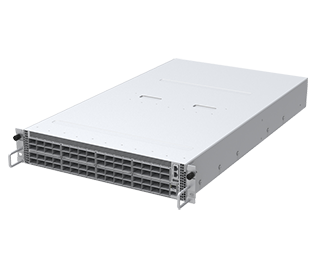Introducing Celestica’s 51.2Tb 800GbE Switch: Helping to Meet the Growing Demands for AI-driven Bandwidth
Modern data center networks are being transformed by at least three main factors: artificial intelligence (AI), cloud computing and data growth. The rapid rise of artificial intelligence, the shift of data and applications to a cloud-centric approach,
and the vast amounts of global data that continues to increase exponentially, are making it harder for organizations to balance technology and networking infrastructure with real-world demand. As such, bandwidth, network performance, and flexibility
are challenged at every turn. Those that can respond efficiently will better meet their goals, outperform their competition and keep their stakeholders happier.
Networking is often the AI bottleneck
From optimizing ecommerce platforms, to providing more accurate healthcare diagnoses, or entertaining us on the big screen, businesses are using AI in myriad ways. As exciting as these types of applications are, AI requires tremendous amounts of bandwidth.
While AI uses compute performance and a source of raw data, in order for the models to work they need to exchange data sets, which requires network bandwidth. The lack of ample networking bandwidth results in bottlenecks. Thinking about it in human
terms, two or more people working together can solve a problem faster, but only if they can talk to each other at the same rate as their problem-solving ability. Being able to maximize the efficiency of AI connectivity and overcome scale-out bottlenecks
will maximize the potential of AI-ML systems.
Cloud computing hasn’t slowed down
Cloud computing is putting unprecedented pressure on today’s networks. Increasingly, enterprises are taking advantage of the productivity, accessibility and reliability benefits gained when applications run on the cloud. This steady growth in cloud computing
is fueling demand for even more network bandwidth and higher data-transfer rates inside cloud platforms and between their end users. Cloud apps are no longer side-projects or only for low-demand applications. They now perform critical functions vital
to the modern enterprise. Many new data center networks are now designed on a spine-leaf networking topology in order to minimize latency and bottle necks. Spine switches that offer high port density combined with high throughput are key to putting
data where it’s needed in a cloudified world.
The explosive growth of data
The total amount of data created, captured, copied, and consumed globally continues to accelerate. From 2 zettabytes in 2010, to 16 zettabytes in 2015, the data consumption is expected to reach 180 zettabytes by 2025. Organizations will need the right
technology to manage both structured and unstructured data such as videos, emails and social media posts. Those that limit the speed of their networks will limit their speed of innovation.
The implications of AI, cloud migration and data growth are obvious – all are putting increasing demands on network bandwidth and performance. Organizations are increasingly taking a second look at open systems with non-proprietary networking operating
systems (NOS) that won’t force vendor lock-in with slower refresh cycles. Celestica is helping to mitigate these challenges with powerful new systems that lead the way in performance, flexibility and openness.
Celestica leads the way in next generation 800G switching
 Celestica's DS5000, 800 GbE Switch
Celestica's DS5000, 800 GbE Switch
The DS5000 – Celestica’s new 2U 64-port 800GbE switch will help manage many of these challenges. Performance and high bandwidth are the most critical aspects of data center switches that are needed to meet the demands of AI, cloud and data growth. The
DS5000 is a powerful, high-performing, high-bandwidth switch with 64 OSFP 800GbE Ports, providing a 51.2 Tbps Ethernet-based fabric solution within a 2U form factor. The ports will be multi-speed capable at 50GbE / 100GbE / 200GbE / 400GbE allowing
for maximum flexibility and enhanced power and thermal budgets to support a variety of long reach and coherent optic modules. Additionally, they will be available with high-performance processor options up to 8 cores.
Aside from raw performance, organizations that implement a more open and flexible design are also able to innovate faster as they are not tied to the development schedules of proprietary vendors. That’s why open distributions of SONiC (Software for
Open Networking in the Cloud) will be available for the DS5000. Celestica is also a long-time member of the OCP community, and has incorporated an Open Network Install Environment (ONIE) installer in the DS5000 to support additional open and third-party
network operating systems.
Transforming connectivity
There is no doubt that data centers and, by extension, their networks will continue to be pushed to the limit by the growing use of AI technology, the increased adoption of cloud-computing and the explosive growth of data consumption. The new DS5000 has
been designed to help organizations meet these demands and transform the future of connectivity with true 800G performance combined with a flexible, open approach to scaling and managing data center spine switching.
Learn more about the DS5000. Come see us at booth A15 at the OCP Global Summit in San Jose from October 17-19. Speak with our team
about the DS5000, and mark your calendar to catch expert speaker Jeff Catlin at 8:50 a.m. on October 19 talk about the increasing need for data center bandwidth “800G: Empowering Open Platforms
for Unprecedented Speed and Agility.”